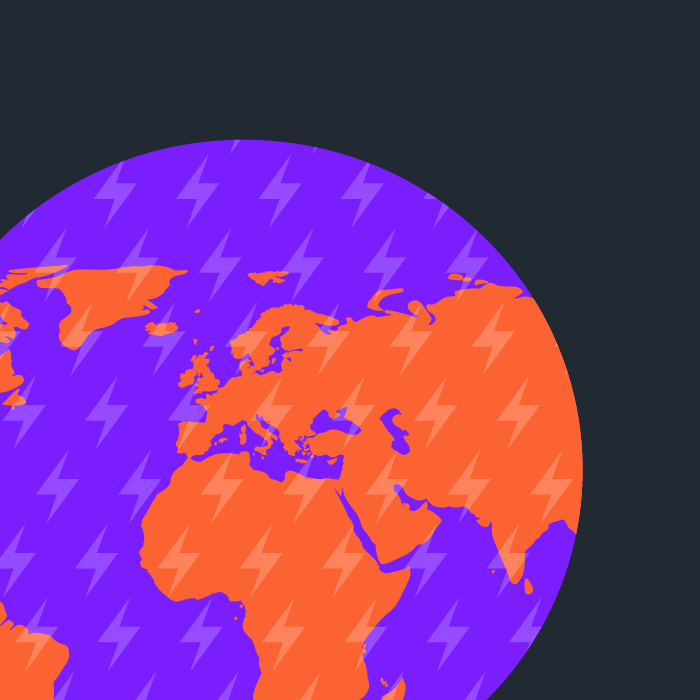Weather affects almost all business operations, with some quite literally depending on it. Offshore operations, like liquid natural gas (LNG) handling at sea, is a good example.
Naturally, severe weather poses a significant safety risk to highly-flammable cargo like oil and gas, particularly during loading and unloading. Where oil and gas products are concerned, lightning is one of the greatest hazards - especially at sea.
Maritime lightning risks
The likelihood of water being struck decreases the further the area is from shore and the deeper the water gets. Although lightning doesn’t strike the ocean as frequently as it does land, when it does, it spreads out over the water, which acts as a conductor. On land, the impact of a lightning strike is usually vertical, affecting the point of impact and heading downwards. But when hitting its surface, water’s conductivity causes lightning to spread horizontally. When this happens, anything near the point of strike is at risk – including vessels. (And yes, fish too.)
The dangers of lightning and severe weather aren't unique to offshore operations. Every year, tanks, refineries, and oil and gas terminals around the world are damaged by lightning strikes, causing enormous damage to infrastructure, the environment, and in the worst cases, lives. One Vaisala survey reveals that for oil and gas terminals, the estimated cost (in USD) of a shutdown is $1,000 a minute – that’s $60,000 for every hour of downtime. During loading or offloading processes, each hour of outage time can cost LNG terminals $20,000.
Successful LNG operations require complex knowledge of electrical storm behavior and detection. They must also have the capability to support hazardous locations – areas where highly-flammable fumes have the potential to cause fires or explosions if ignited - as one strike of lightning can cause fires or even explosions under the right (or wrong) circumstances. Though relatively uncommon, these occurrences have been known to happen – as was the case at a Mississippi refinery in April of 2023. Reliable real-time lighting data is crucial in this equation.
Planning for inclement offshore weather is key
While lightning is unavoidable, appropriate planning and protocol for its occurrence will help to prevent accidents, protect lives, and minimize downtime.
A comprehensive system is inclusive of offshore weather data, providing early warning and tracking of thunderstorm movement. This helps the crew plan and time safety measures for fueling, loading, or offloading operations. Xweather's lightning API allows LNG terminals to pointedly identify convective activity and areas where convective activity is forecasted to occur in the near future.
Often, costly single-point lightning sensors used in ports and terminals cannot tell you exactly where the lightning is or when it will occur. A true lightning-sensing system requires numerous high-strength sensors along with forecasting algorithms, which are complex to build in-house. Lack of a sophisticated lightning network can be challenging to plan around. The advantages of lightning data provided through the Xweather API — powered by Vaisala Xweather's Global Lightning Dataset — include:
Better location accuracy (100 meter - 1 km*) and detection efficiency (80% - 95% CG flash globally*) than single-point sensors or other global lightning detection networks
No sensor costs or maintenance
Accurate distance measurements to your point of interest
Accurate classification of in-cloud and cloud-to-ground lightning
Lightning threats forecasting
100km radius for longer-term storm tracking
The key inputs that go into formulating a storm’s threat potential are:
Location of operations
Proximity to the storm
Storm’s speed, direction, and intensity
When detecting lightning, it is important to know the time, location, type, and frequency of all strikes associated with a storm. It’s also crucial that a lightning detection system can identify storms that develop directly overhead. Though it’s relatively rare, this is much more dangerous, as thunderstorms that develop overhead require an instant warning of the immediate threat.
Make thunderstorm detection part of your plan
Severe alerts and lightning threats allow users to maintain situational awareness of storms around them and the imminent threats they pose. With this knowledge, teams can implement safety protocols to avoid accidents or weather-induced disasters.
Xweather's Weather API and Maps subscription provides end-users with access to weather API, raster mapping, and MapsGL functionality, enabling them to track storms, lightning, severe alerts, and more through multiple channels – either visually or in a classic API format that can be interpreted client-side. With this subscription, users can call or display flash lightning data for the last five minutes for both cloud-to-cloud and cloud-to-ground lightning, which provide contextualization for incoming storms.
The features of the Weather API and Maps subscription and the lightning endpoints and mapping layers it provides will provide all the weather data that offshore LNG terminals need to take appropriate action — including the many mapping layers available through MapsGL, the recommended weather visualization toolset for low-bandwidth settings.
Where instantaneous alerting is paramount, webhooks are an invaluable solution, providing pushed weather data for immediate notification of impending weather concerns.
Armed with this information and these tools, you can establish a proper warning system that keeps everyone safe while limiting downtime.
How can weather benefit your operations?
Take our data and mapping for a free 30-day test drive or talk with one of our technical experts to learn more.




